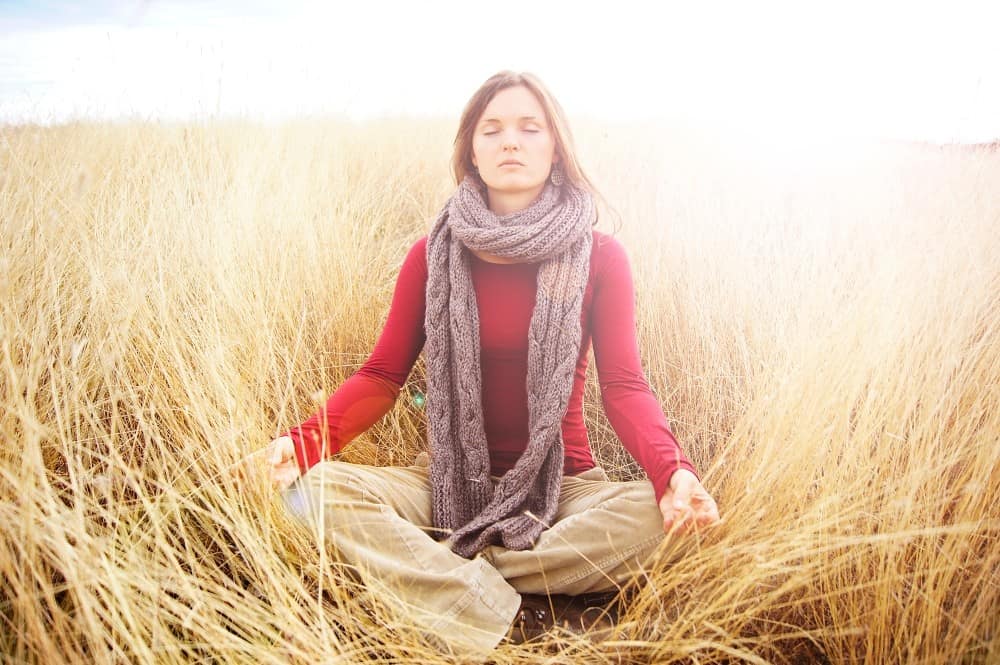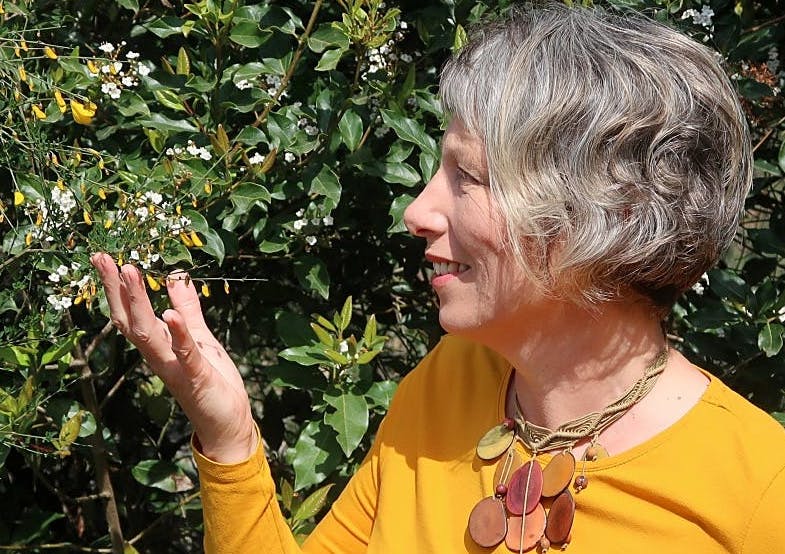Different Ways To Meditate: Pick One To Suit You

If you’re new to meditation, it can be difficult to know where to start, especially since there are so many different ways to meditate.
You’ve probably heard about all the wonderful benefits of meditating but you might still be feeling a bit confused about how to meditate properly, without feeling silly and wondering if you’re doing it right.
There are many meditation styles so the best thing you can do is try a few until you find a practice that suits you. The method you choose will impact how meditation feels for you.
I like to meditate at least once a day as I find it helps settle my mind and overcome the stirrings of overwhelm. I also find it helps me to be more present when I’m out in nature, and to notice what’s ‘alive’, for me in that moment and in the world around me.
Over the years, I’ve tried lots of different meditation methods and have found several that I enjoy, and some that have become my ‘go to’ practices. I’ll describe the ones I’ve found especially helpful in this article.
First, let’s bust that ‘clear mind’ myth of meditation
No matter what anyone tells you, it’s impossible to clear your mind of all thoughts.
My first experiences of meditation were the five or 10 minutes of shavasana you get at the end of a yoga practice. While I enjoyed lying down and relaxing my body, I would get frustrated with an instructor who was telling me to empty my mind.
I felt like a failure because I found myself thinking about not thinking!
Now I know that it isn’t possible for us to stop thinking completely, which certainly takes the pressure off.
What you can do with meditation is calm the mind and stop focusing on all the mental chatter that stresses you out.
How to deal with unwanted thoughts during meditation
If thoughts pop into your mind during your session, one way to manage them is to imagine that they are clouds floating peacefully across the sky.
You can notice these ‘thought clouds’ without getting caught up in them.
Sometimes, I like to think of them as balloons; if they drift my way, a gentle tap will send them off in another direction. Or dandelion seeds that just need a puff of breeze to make them float away.
Do you need to sit cross-legged to meditate?
Absolutely not!
I can’t sit cross-legged for any length of time, it’s just not comfortable. The point of meditation is to be in a relaxed state so if you’re bothered about the pain in your knee or your bum because you’re in an awkward (for you) pose, it’s not going to work.
You can lie down if you like, or sit upright on a chair or sofa with a straight back. Support yourself with cushions if necessary so you you’re not slouching. Feet on the floor is best so that you can feel connection with the ground.
I sometimes meditate standing up!
You don’t even need to be still. As you’ll see below, moving meditation is also a possibility.
And no, you don’t have to make a circle with your thumb and forefinger. Rest your hands in a comfortable position that’s not creating strain anywhere else in your body.
What is focused meditation?
I’ve tried many different meditation techniques over the years and I find that some kinds of focused meditation work well for me.
It didn’t at first, because I didn’t really understand what I was supposed to do, how it was supposed to work or how I should feel. Although I went in with an open mind, I was also slightly anxious, which gets in the way of complete relaxation.
This was an extended meditation session offered on a yoga retreat I went on a few years back. It was a fully guided session so we lay down, eyes closed and tried to visualise the candle flame that the instructor was describing.
You could also do this with eyes open and focus on a real candle or other object.
The point is to have something to direct your attention towards that shifts it away from the mental chatter. Any time you find you’ve strayed and gone down a rabbit hole of everyday thoughts, bring your mental or real gaze back to the focal point.

Using your breath as the focus for meditation
I find the simplest focal point for me is my breath. It’s always there and it helps you to be more in tune with your body when you pay attention to the quality of your breathing.
The beauty of this type of meditation is you can do it any time, any place, with no need for apps or props. Do it.
Try this breathing meditation now:
Find a comfortable position. You can lie down or sit with your back straight and feet on the floor, or even do this standing up for micro meditation sessions.
Close your eyes if you like. If you choose to keep them open, soften your gaze so that you’re not overstimulated.
Take a deep breath in and on the out breath, relax your body.
Take another deep breath in. On the out breath, relax your mind.
Take a third deep breath in. On the out breath, let go of your emotions.
Return to normal breathing.
Notice your breath as it moves in and out of your body.
You can continue like this, or pay attention to the way your breath moves your body.
There’s no need to change anything unless you want to make slight adjustments for comfort. Continue for as long as you like.
When you’re ready to stop meditating, gently start to move your fingers and toes then open your eyes.
Mantra meditation
With mantra meditation, instead of focusing on the breath or an object, you keep the monkey mind quiet by repeating a word or phrase over and over to yourself.
This can be anything at all but it can be useful to choose something that doesn’t hold any verbal meaning for you. The friend who taught me this method suggested the word Ayim for me, which turns out to be a name.
I have only just looked up the meaning on Google and I wonder if he chose it on purpose. There are lots of interpretations of Ayim but this made me chuckle as it sounds about right for me:
“Generally you are good-natured, though at times you can be blunt and sarcastic.”
When I first learned the mantra meditation method, I practiced for 20 minutes in the morning and in the evening after finishing work. Now, I tend to revert to it only when I’m finding it hard to switch off just through focusing on my breathing. Sometimes, when I’m lying awake at night, the mantra meditation helps me get back to sleep.
A popular choice for mantra meditation is So Hum, a Sanskrit phrase that translates as “I am she/he/that”. In Vedic philosophy, “that” is often interpreted as “the Universe” and reflects our interconnectedness with universal energy and all that is.
If you try this mantra, mentally say “So” on the inbreath and “Hum” on the out breath.
Just do nothing
A few years ago, I was constantly on the go and at the point where I couldn’t even sit still in the garden. Whenever I went out there for a cup of tea or something, I’d find myself, pulling up weeds or tidying things. I just couldn’t relax.
When I first started working with a coach, she could see how frazzled I was during our first one to one session. One of the things she ‘prescribed’ for me was literally to just lie on the floor for 10 minutes a day and do nothing. Indoors or outdoors.
It really helped. I wasn’t consciously meditating but just being still with nothing to do helped me to ground a little bit, and feel calmer.
Now, I’m pleased to report that I have got very good at sitting still and doing nothing in particular. It’s a skill worth cultivating in our ever-busy lives.

Loving-kindness meditation
I discovered loving-kindness, meditation when I was doing my Positive Psychology course and I’ve been practicing it on and off ever since. It’s a great way to boost one our 10 positive emotions, namely Love.
Essentially, loving-kindness means thinking about people in a warm, loving way and sending them good wishes. Doing this as a meditation practice is a great way of connecting with yourself, and with other people, even when you’re on your own.
It also has proven physiological and psychological benefits. Loving-kindness meditation does your heart good and lifts your own mood. It also makes you more aware of how we’re all fundamentally the same. We all want to be happy and free from suffering, no matter who we are.

When I started doing this practice, I really felt a warm glow in my heart. I can still cultivate that now but some days I have to work a little bit harder to feel that warmth.
According to Barbara Fredrickson, author of Love 2.0: Finding Happiness and Health in Moments of Connection, and renowned professor of Positive Psychology, an hour a week of loving-kindness meditation is sufficient to get the physical benefits from it. You can split that up into around 10 minutes a day or 3 x 20 minutes sessions, spread throughout the week.
How to do a loving-kindness meditation
You can do this lying, seated or while moving, although it’s easier to practice when you’re still, at least to begin with.
Close your eyes or soften your gaze and take a few deep breaths, relaxing your body, mind and emotions on each out breath.
Return to normal breathing and focus on your breath.
Traditionally, you would start with yourself but if you find that too challenging, you can begin with someone you are very fond of, or a beloved pet.
Whoever you choose, start thinking of their positive qualities and imagine your heart getting warmer as it fills with tender feelings towards this person.
Now send this person good wishes. You can use these phrases or adapt them to suit:
May you be safe.
May you be happy.
May you be healthy.
May you live with ease.
Repeat these phrases a few times and imagine sending them the warmth from your heart in the form of energy.
Once you’ve done this for yourself and a loved one, you can move onto someone you don’t know very well and repeat the process.
Then form a group in your mind of the people you care about and send them good wishes collectively.
The final step is to extend these good wishes to all beings throughout the world.
If you’d like more details on this, I recommend reading Love 2.0. Or try Barbara Fredrickson’s free guided meditations.
Moving meditation

No, you don’t have to sit cross-legged on the floor, surrounded by candles to meditate. You can do it almost anywhere, without cushions and props. You can also do it while you’re cooking, ironing, walking the dog or any other activity that doesn’t require much concentration.
I discovered moving meditation thanks to the Healthy Minds app. Based on scientific research, the programme is designed to help you train your brain to develop greater self awareness, appreciation, compassion and insight through a mixture of meditations and teachings.
For a moving meditation, start by focusing on your breath. Think about the sensations in your body as you’re doing your activity.
Choose a focus for your practice; it could be to notice the sounds around you or to feel gratitude for things or people in your life. You could think about acts of kindness that people have shown you, or that you have witnessed.
There are many possibilities here. Try the app (above) for guided practices.
Many people, including myself, treat their daily walk in nature as a meditative practice. If you start focusing on the nature and being more mindful about what you see and hear, the annoying thoughts fade into the background. You can also use the opportunity to connect with nature on a sensual level through touch, smell or even taste.
Or cultivate the positive emotions of awe, joy and interest as you marvel at the intricate patterns that nature makes and the beauty of flowers and other plants or wildlife.
Get your free copy of my 5 Quick & Easy Ways To De-Stress By Connecting With Nature
Journaling as meditation
The daily brain dump journaling I do every morning can also be seen as a form of meditation. For Julia Cameron, author of The Artist’s Way, and originator of the Morning Pages practice, it is a way clearing her mind of the clutter so that she’s got headspace for creativity in the rest of her day.
I definitely find journaling helpful to get niggling thoughts out of my mind, either first thing every day, or when I need to examine a particular issue. Or rage about something on paper.
All you need for this is pen and paper and a bit of peace and quiet.
Which of these different ways to meditate have you tried?







